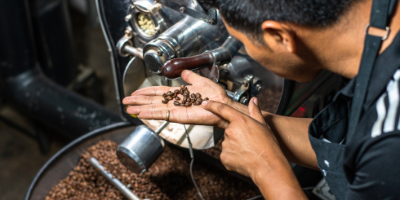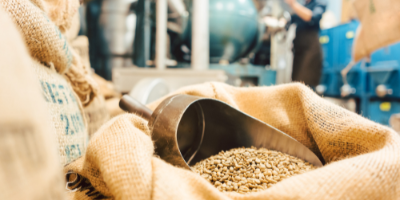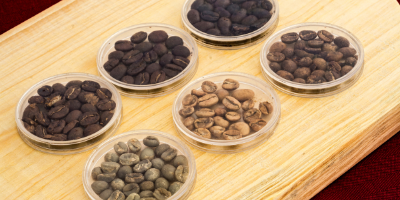The Aroma of Coffee: Why Does It Smell So Good?
Posted by Simone, The Coffee Girl on 12th Sep 2022
The Science Behind the Smell of Coffee
It's a chemical reaction that causes the beans to smell and taste so great. This reaction is known as a Maillard reaction. Its name comes from the chemist who first described the reaction, Louis-Camille Maillard, in 1912.
The Maillard Reaction is a chemical reaction between amino acids and reducing sugars that gives browned food and drink its distinctive flavour. As well as coffee, many other foods undergo this reaction. It is named after French chemist Louis Camille Maillard, who first described it in 1912 while attempting to reproduce biological protein synthesis.
The reaction is a form of non-enzymatic browning which typically proceeds rapidly from around 140 to 165 °C. Many recipes call for an oven temperature high enough to ensure that a Maillard reaction occurs. At higher temperatures, caramelization (the browning of sugars, a distinct process) and subsequently pyrolysis (final breakdown leading to burning and the development of acrid flavours) become more pronounced.
In the coffee roasting process, Maillard reactions can produce many different flavour compounds depending on the temperature, the roasting time, and the presence (and quality) of air.

Coffee Roasting & the Maillard Reaction
Roasting is a fundamental stage in a coffee's journey from seed to cup. Not only does it unlock the potential of green beans by releasing thousands of aromatic compounds, but it also makes them brittle and porous enough to effectively grind and brew.
During roasting, several complex chemical reactions occur that have a significant impact on a coffee’s final flavour. One of the most important is the Maillard reaction, also known as the “browning phase”, which occurs when sugars and proteins are subjected to heat.
For specialty coffee roasters, understanding the Maillard reaction is vital to bringing out the best flavours and achieving the desired roast profile of each particular coffee.
What Are The Different Phases Of Coffee Roasting?
The term "coffee roasting" encompasses several different phases that occur from the moment a green coffee bean is placed into the roaster to the very end of the roast process.
During each phase, countless chemical reactions take place that has an impact on the final flavour of the coffee. These reactions transform dull-tasting green beans into an aromatic and flavourful product that's ready to grind and brew.
A typical roast process can be divided into three key phases.

The drying phase
When green beans are put into a roaster, a sharp drop in temperature is recorded as the cool beans come into contact with the hot roasting vessel. After a short time, the beans and the roaster reach a "turning point", in which the temperatures of both are the same before they start to rise in parallel.
The main transformational changes that occur in this phase are an increase in bean volume and internal pressure (due to the transformation of water into steam), loss of mass and density, and a colour change from green to yellow.
The length of time and the temperature of the roasting drum during the drying phase are critical to the overall development of a roast. Generally, it should be around 40% of the entire process.
Caramelisation
The caramelisation phase is generally considered to be the time between the beans turning yellow and the "first crack" (when the pressure inside the beans causes them to burst open). Its name refers to the breakdown, or caramelisation, of many of the sugars inside the coffee beans.
The most important of these caramelisation reactions is the Maillard reaction, a non-enzymatic reaction between amino acids and reducing sugars that causes coffee beans to “brown”. The reaction also produces an abundance of flavour and aromatic compounds in the coffee, which contributes to its distinct taste.
Controlling the length of the Maillard reaction and the rate at which it occurs is crucial to achieving desired flavour and roast profiles.
Maillard reactions tend to produce savoury, floral, chocolatey, earthy, and roasted aromas, among others.
First crack & development phase
The third phase starts at the first crack and finishes at the end of the roast cycle, with the final temperature dependent on the desired roast profile.
At the first crack, numerous chemical reactions occur very quickly, with the rate at which they occur largely defined by the momentum set by decisions made earlier in the roast.
Along with the coffee’s final temperature, these reactions most clearly modulate a coffee’s sweetness and acidity. Generally, the shorter time a coffee spends in development and the lower its final temperature, the more it will express sweetness and acidity.
On the other hand, the longer it spends in development and the higher its final temperature, the more it will express caramelised or roasted character with lower acidity. This is also the phase of a roast when the darkness of a roast is determined: the longer the development time, the darker the roast.

How Does The Maillard Reaction Affect The Flavour Of Coffee?
Manipulating the Maillard reaction can have a significant impact on a coffee’s characteristics.
For example, coffee roasters can raise the complexity of the sugar browning, as well as increase texture and mouthfeel by lengthening the Maillard reaction. Conversely, a shorter reaction tends to soften the body and mouthfeel, while reducing complexity in sweetness and flavours.
Generally speaking, if you reach the Maillard reaction too quickly, you’re going to leave too many organic acids in the cup, which will be unpleasant, but if you take too long in this phase, then you’re going to dissolve too many solubles in the coffee, which could produce more body but with dirty, earthy tones.
Part of the reason for these differences is down to melanoidins. Melanoidins are brown nitrogen-containing polymers that form in roasted coffee during the Maillard reaction. As well as flavour, they have a considerable impact on the viscosity of coffee when brewed.
The longer the Maillard reaction, the more melanoidins are produced and the higher the molecular weight of the beans. This is why characteristics such as mouthfeel and body differ across different roast profiles from the same batch of coffee.
The Maillard reaction is essential to the development of a coffee's characteristics, affecting everything from flavour notes and bitterness to body and mouthfeel. Therefore, roasters need to understand how to manipulate the Maillard reaction to unlock the full potential of their coffee and achieve the desired roast profile.


